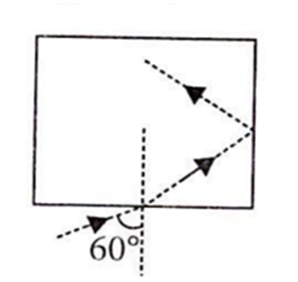CBSE Multiple Choice Questions
Multiple Choice QuestionsA prism of a certain angle deviates the red and blue rays by 8 and 12, respectively. Another prism of the same angle deviates the red and blue rays by 10 and 14, respectively. The prisms are small angled and made of different materials. The dispersive power of the materials of the prisms are in the ratio
5 : 6
9 : 11
6 : 5
11 : 9
A 2.0 cm tall object is placed 15 cm in front of a concave mirror of focal length 10 cm. What is the size and nature of the image?
4 cm, real
4 cm, virtual
1.0 cm, real
none of these
The least distance of vision of a longsighted person is 60 cm. By using a spectacle lens, this distance is reduced to 12 cm. The power of the lens is
+ 0.5 D
+ ( 20/30 ) D
(10/3) D
+ 2.0 D
Light wave enters from medium 1 to medium 2. Its velocity in 2nd medium is double from 1. For total internal reflection the angle of incidence must be greater than
30o
60o
45o
90o
A transparent cube of 15 cm edge contains a small air bubble. Its apparent depth when viewed through one face is 6 cm and when viewed through opposite face is 4 cm. The refractive index of material of cube is
2.0
1.5
1.6
2.5
Focal length of objective and eye piece of telescope are 200 cm and 4 cm respectively. What is the length of telescope for normal adjustment?
196 cm
204 cm
250 cm
225 cm
For a situation shown in figure, find the refrective index of glass so that it will suffer total internal reflection at the vertical surface

1.732
1.5
1.31
1.6
Assertion: Electron microscope has more resolving power than optical microscope.
Reason: We can control the energy of electron.
If both assertion and reason are true and reason is the correct explanation of assertion.
If both assertion and reason are true but reason is not the correct explanation of assertion.
If assertion is true but reason is false.
If both assertion and reason are false.
Assertion: When an object is placed between two plane parallel mirrors, then all the images found are of equal intensity.
Reason : In case of plane parallel mirrors, only two images are possible.
If both assertion and reason are true and reason is the correct explanation of assertion.
If both assertion and reason are true but reason is not the correct explanation of assertion.
If assertion is true but reason is false.
If both assertion and reason are false.
A person uses + 1.5 D glasses to have normal vision from 25 cm onwards. He uses a + 20 D lens as a simple microscope to see an object. What is the maximum magnifying power if he uses the microscope without glasses.
8
9
10
11

